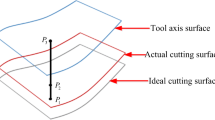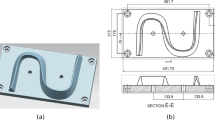Abstract
In this paper, a convenient way to detect machining precision of five-axis CNC machine tool is suggested in theory. In a general way, NAS979 is cut to test machine tool; however, it fails to evaluate the combination motions of rotary axes sufficiently. Therefore, a novel S-shape test part, called ‘S’ test piece, has been presented to demonstrate the machine tool’s capabilities. As a new test specimen, ‘S’ test piece has some advantage to exhibit the machining precision of five-axis machine tool. There are some visible marks related to performance of machine tool experimentally, however, the reasons for these abnormal marks are uncertain theoretically, the performance of the servo system may be one of the causes. In order to figure out the definite cause of the abnormal morphology, a simulated platform with the servo system is set up to amplify and the normal errors that come from the tracking of axes are presented. The simulation results of the abnormal morphology of ‘S’ test piece is provided. And the surface quality is evaluated by the peak-to-peak value (Vpp). There are obvious marks in four special regions of ‘S’ test piece that simulated with poor performance servo system, and these marks are invisible in the surface of ‘S’ test piece that simulated with good performance servo system. Vpp in these four regions changes greater than the other regions of ‘S’ test piece. The Vpp that simulated by the poor performance servo system is about 15 times larger than the error simulated by the optimized performance servo system in these four special regions. While, Vpp of other regions is essentially invariant. Then, the machining experiments of ‘S’ test piece are conducted with the standard suggested process. The abnormal morphology of machined ‘S’ test piece is so obvious that it can be observed by the naked eyes, without any test equipment. And the result of the experiment is consistent with the simulation result, which means that tracking errors of servo system have direct influence on surface morphology abnormality, and the surface quality of ‘S’ test piece could display the dynamic performance of the servo system intuitively in theory. As a standard comparison object, the surface quality of NAS979 test piece is analyzed through the same platform with the poor performance servo system, the largest Vpp is about 0.00022 mm, one eightieth smaller than ‘S’ test piece at least. And machining experiment is also carried out with the poor performance machine tool, the surface is so smooth that unexpected texture cannot be observed by the naked eyes, it should be test by the special measurements. The simulation results and experiment results both show that the surface quality of ‘S’ test piece is hugely worse than NAS979. Besides, there are several special regions of ‘S’ test piece to exhibit the surface texture waving with certain parameters. In a word, ‘S’ test piece is high effectively to exhibit the dynamic performance of the servo system of five-axis machine tool.
Similar content being viewed by others
References
Ye T, Xiong CH (2008) Geometric parameter optimization in multi-axis machining. Comput Aided Des 40(8):879–890
Schmitz TL, Ziegert JC, Canning JS, Zapata R (2008) Case study: a comparison of error sources in high-speed milling. Precision Eng J Int Soc Precis Eng Nanotechnol 32(2):126–133
ISO/CD 10791–6:2009 (2009) Test conditions for machining centers—part 6: accuracy of feeds, speeds and interpolations
Renishaw: http://www.renishaw.com
IBS Precision Engineering: http://www.ibspe.com
Fidia S.p.a.:http://www.fidia.it
NAS979 (1969) Uniform cutting test-NAS series, metal cutting equipment. NAS, USA
Song Z, Cui Y (2009) S-shape detection test piece and a detection method for detecting the precision of the numerical control milling machine. United States, Invention Patent, US8061052B2
Clarysse F, Vermeulen M (2004) Characterizing the surface waviness of steel sheet: reducing the assessment length by robust filtering. Wear 257(12):1219–1225
Al-Regib E, Ni J, Lee SH (2003) Programming spindle speed variation for machine tool chatter suppression. Int J Mach Tools Manuf 43(12):1229–1240
Gagnol V, Bouzgarrou BC, Ray P, Barra C (2007) Model-based chatter stability prediction for high-speed spindles. Int J Mach Tools Manuf 47(7–8):1176–1186
Ahmadi K, Ismail F (2010) Machining chatter in flank milling. Int J Mach Tools Manuf 50(1):75–85
Li ZZ, Zheng M, Zheng L, Wu ZJ, Liu DC (2003) A solid model-based milling process simulation and optimization system integrated with CAD/CAM. J Mater Process Technol 138(1–3):513–517
Bae SH, Ko K, Kim BH, Choi BK (2003) Automatic feedrate adjustment for pocket machining. Comput Aided Des 35(5):495–500
Guzel BU, Lazoglu I (2004) Increasing productivity in sculpture surface machining via off-line piecewise variable feedrate scheduling based on the force system model. Int J Mach Tools Manuf 44(1):21–28
Jiang L, Yahya E, Ding GF, Hu MH, Qin SF (2013) The research of surface waviness control method for 5-axis flank milling. Int J Adv Manuf Technol 69(1–4):835–847
Jung CY, Oh JH (1991) Improvement of surface waviness by cutting force control in milling. Int J Mach Tools Manuf 31(1):9–21
Luo X, Cheng K, Ward R (2005) The effects of machining process variables and tooling characterisation on the surface generation. Int J Adv Manuf Technol 25(11–12):1089–1097
Luo XK, Cheng K, Luo XC, Liu XW (2005) A simulated investigation on the machining instability and dynamic surface generation. Int J Adv Manuf Technol 26(7–8):718–725
Yamaguchi F (1988) Curves and surfaces in computer aided geometric design. Springer
Kato N, Tsutsumi M, Sato R (2013) Analysis of circular trajectory equivalent to cone-frustum milling in five-axis machining centers using motion simulator. Int J Mach Tools Manuf 64:1–11
Zhang LB, Wu T, Huang FL (2014) A coupling motional control method based on parametric predictive and variable universe fuzzy control for multi-axis CNC machine tools. Int J Adv Manuf Technol 74(5–8):1097–1114
ISO 12085. 1996 (1996) Geometrical Product Specifications (GPS)—surface texture: profile method—motif parameters
Author information
Authors and Affiliations
Corresponding author
Rights and permissions
About this article
Cite this article
Jiang, Z., Ding, J., Song, Z. et al. Modeling and simulation of surface morphology abnormality of ‘S’ test piece machined by five-axis CNC machine tool. Int J Adv Manuf Technol 85, 2745–2759 (2016). https://doi.org/10.1007/s00170-015-8079-x
Received:
Accepted:
Published:
Issue Date:
DOI: https://doi.org/10.1007/s00170-015-8079-x




